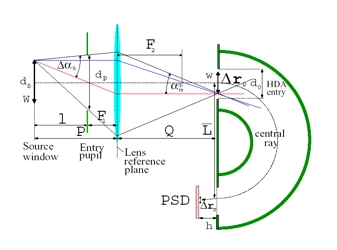Ultimate energy resolution of a hemispherical analyzer using a
cylindrically symmetric injection lens and virtual entry aperture
T.J.M. Zouros1,2, E.P. Benis3
1) Department of Physics, University of Crete, Heraklion, Crete, Greece
2) Inst. of Electronic Structure and Laser, FORTH, P.O. Box 1527, 71110 Heraklion, Crete, Greece
3) Dept. of Physics, J.R. Macdonald Lab., Kansas State University, Manhattan, KS 66506-2604
Today's modern hemispherical deflector analyzer (HDA)
is equipped with a multi-element
zoom lens and position sensitive detector (PSD)
[as for example in Electron Spectroscopy for
Chemical Analysis (ESCA)] and therefore enjoys
a very large collection efficiency. The zoom lens
focuses the source electrons into the HDA entry,
thus increasing the overall collection solid
angle. Pre-retardation, also supplied by the lens,
is used to further improve the overall energy resolution
of the entire spectrometer by decelerating the particles
from an initial source energy T
down to a much lower energy t just prior to HDA
entry.
Recently, we have presented a simple method
for obtaining the theoretical ultimate resolution
and associated linear lens magnification of the
combined lens-HDA spectrometer [1] under the
constraints of the Helmholtz-Lagrange law for
conjugate object-image pairs. Our results are
practical as they are analytic, giving the minimum
resolution at the optimal magni»cation, in
terms of basic experimental parameters. Our formulation
can be readily used in the design and
performance evaluation of such a spectrometer.
A schematic of the relevant geometry is
shown in Fig. 1. The drawing has been simplified
by approximating the (thick) lens by a
thin lens. The vertical dimensions are particularly
enhanced. The depicted lens represents a
generic lens substitute of the more complicated
multi-element lens used in typical ESCA setups.
Here, we report further on our recent results.
Our method can in principle be extended with
some modifications to include all particle spectrometers
utilizing a virtual entry slit whose size
is controlled by a cylindrically symmetric lens
and should therefore be of general interest to the
spectroscopy community at large.

Figure 1: Schematic geometry of typical lens-HDA spectrometer. The object
diameter
dS is focused by the lens and imaged onto the HDA entry plane as
Δr0 = |ML|dS.
Pre-retardation changes the energy of the central ray from W
at the source to w just prior
to HDA entry. For zero beam angle, the pencil half-angle
ΔαS, defined by the entry pupil, is related
to α*m via the Helmholtz-Lagrange law,
dSΔαSW1/2 =
Δr0α*mw1/2
[1].
References:
[1] T.J.M. Zouros and E.P. Benis, Applied Phys. Let. 86, 094105 (2005)
This work was supported by the
Chemical Sciences, Geosciences and Biosciences Division,
Office of Basic Energy Sciences,
Office of Science,
U.S. Department of Energy.
Submitted to ICPEAC, July 2005 in Rosario, Argentina.
This abstract is also available in
Adobe Acrobat format.
